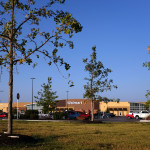I. Getting Around in Manor
by Tyler Whitson, Austin Monitor
While it’s undeniable that Manor is growing very quickly, it’s unclear how that growth will impact mobility for residents.
Manor Mayor Rita Jonse offered her take on Sept. 29. “We’re trying to get ahead of the problem before it gets to be like Austin,” she said with a chuckle, referring to the major congestion issues facing the state capital.
“We are growing, we’re going to continue to grow,” Jonse continued. “We’re the last bastion (in the region) that hasn’t been developed and so everything’s now flowing our way — which is great — and we’re just trying to get ahead of the traffic flow.”
Efforts to improve mobility and increase transportation options are particularly important in Manor because residents, many of whom are low-income, often have lengthy commutes. Based on U.S. Census Bureau data, more than one fifth of the population lived below the federal poverty level in 2013 and the average travel time to work was close to 39 minutes.
Many of Manor’s congestion problems have to do with the fact that there are few ways in and out of the city on its west side. Traffic is heavy there due, in part, to commuters traveling between Manor, Austin and other cities and students traveling to and from three schools – elementary through high school – that are clustered together on the town’s western border.
While there are other ways to get into Manor from the west, U.S. 290 East is the main doorway, running right through the town. It also connects with the often congested Parmer Lane and SH 130 just west of town, which can create a traffic bottleneck.
“The toll road dumps all the traffic right into Manor right there at the very edge of Manor,” Jonse said, referring to the 290 East Toll, also known as the Manor Expressway.
The city, Jonse said, is proactively searching for solutions to address congestion. For example, she said, it is striving to get a developer to create an additional connection that would alleviate traffic on the west side of town for buses headed to the nearby schools.
Enlarge
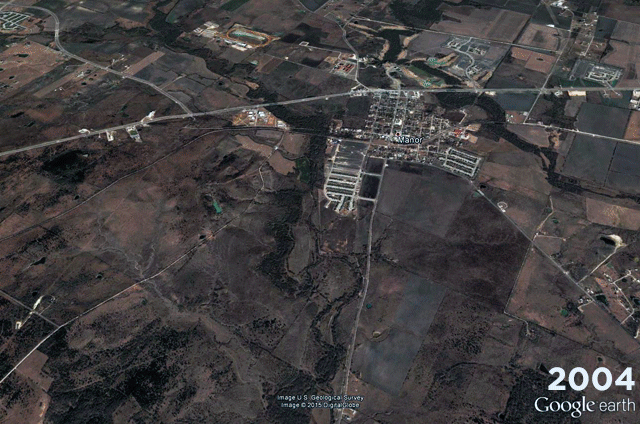
Andrew Weber
In addition, the cities of Austin and Manor, Travis County and the developer behind the upcoming Wildhorse community to be located between Manor and Austin opened an extension of Parmer Lane on Oct. 7. It runs from Old Highway 20 west of Manor down to SH 130 near Blue Bluff Road and will open up a new connection for commuters.
The City of Austin and Travis County’s Howard Lane extension, slated for completion by the end of the year, will create a new connection into Manor by extending the road from Harris Branch Parkway to the southbound frontage road of SH 130.
Jonse, who represents the Central Texas region’s small towns on the board of directors for the Capital Metropolitan Transportation Authority, or Capital Metro, also noted that the city has successfully lobbied to get the transit provider to include local bus service for Manor in its current budget.
The idea, Jonse said, grew from her quest to make sure that Manor’s senior citizens – particularly those living in a centrally located senior living facility called Manor Town Apartments – would have a way to get to the new Medical Towers at ShadowGlen farther east across 290 or to the Walmart and back home.
“It looks like we're going to be able to incorporate more than just our senior citizens, which is great.” Manor Mayor Rita Jonse
That local service, of course, could also help out low-income individuals who don’t have cars – especially considering Manor has no marked bicycle lanes – and provide additional options to reduce congestion in and around the suburban town.
Jonse said that Manor Independent School District leaders, for example, have told her that students’ parents could benefit from local service. “They’ve indicated transportation issues for parents that don’t have automobiles,” she said.
Michelle Meaux, regional coordination planner for Capital Metro, said that the service will drop people off and pick them up at the centrally located Manor Park and Ride. From there, they can connect with Capital Metro’s Route 990 weekday express bus service that runs between Austin and Elgin, which is about 12 miles east of Manor.
According to Capital Metro spokesperson Melissa Ayala, that service is still in its early planning stages. The agency is reaching out to stakeholders this month and will have public workshops at Manor’s senior community center and city hall in early November. Outreach will involve asking residents for their feedback on potential service maps, pickup and drop-off locations and more.
Once the public input process is complete, Meaux said, Capital Metro aims to have the service running in either summer or fall 2016. It’s not clear yet how often the service will run, what the hours will be or how many stops it will have.
According to Ayala, Capital Metro has set aside $221,000 for the service in its Fiscal Year 2015-16 budget, which went into effect on Oct. 1. Since Manor joined Capital Metro in 1985 and contributes 1 percent of its sales tax to help fund transit, the money will come out of the agency’s general budget, which is funded primarily by sales tax from participating jurisdictions.
“We’re trying to be inclusive of everybody,” Jonse said about the public outreach process as she looked forward to institution of the service. “I’m very excited about this,” she added. “It looks like we’re going to be able to incorporate more than just our senior citizens, which is great.”
II. Between Manor and Austin without a car
by Tyler Whitson, Austin Monitor
Manorites who work or fulfill other needs in Austin but don’t have cars – or would simply rather not add another car to the road – have transit options, but they are few and far between.
The best option is Route 990, the weekday express bus service that the Capital Metropolitan Transportation Authority, or Capital Metro, offers between Elgin and downtown Austin. It utilizes the 290 East Toll, also known as the Manor Expressway, for the fastest commute.
Enlarge

That service, however, is limited to six trips. Three are westbound trips, which pick up at the centrally located Manor Park and Ride every hour between 6 and 8 a.m. to drop off in downtown Austin, and three are eastbound, picking up at three stops in Austin between 4 and 7 p.m., depending on the stop.
Ridership for Route 990 sticks at around 85 daily boardings, according to Capital Metro spokesperson Melissa Ayala. The agency, she said, has no current plans to expand the service.
The infrequent service means that a passenger who misses a morning bus could be an hour late to work, and it makes going into town for a simple doctor’s appointment or other errand a somewhat impractical endeavor, due to the amount of downtime between trips. It also makes commuting to work at a job with nonstandard hours extremely difficult.
Bessie Caceres, who lives in Manor, said that her mother moved from Austin to live with her for a short period of time about two years ago. She had major issues commuting without a vehicle, though, because her regular shift in downtown Austin would start at 3 p.m. and end around 11 p.m.
“It was just so hard for her to get from and to work,” Caceres said. “There was no transportation for her at 11 (p.m.), so we had to come and pick her up in the middle of the night, and then around 3 (p.m.), she would have to call somebody else to give her a ride.”
Caceres said that, after a couple of months, her mother decided to move back to Austin so that she could access more frequent bus service, despite higher rent.
A potential solution to such an issue is the MetroRideShare vanpool service that Capital Metro offers through a contractor called vRide. Under the program, groups of five to 12 riders can lease a van for carpooling on a month-to-month basis.
Manor Mayor Rita Jonse said that there are groups of people who meet regularly at the Manor Park and Ride and utilize the vanpool system to commute to work.
Enlarge

Ilana Panich-Linsman
Enlarge

Ilana Panich-Linsman
If there is not enough demand for vanpooling at a certain time, however, prospective participants may be out of luck.
When asked what she would do if she didn’t have a car, Caceres, who works in North Austin, seemed struck by the idea. “I don’t know what I would do. I wouldn’t have any other choice but to get a car,” she said. “I would have to get a vehicle.”
Enlarge
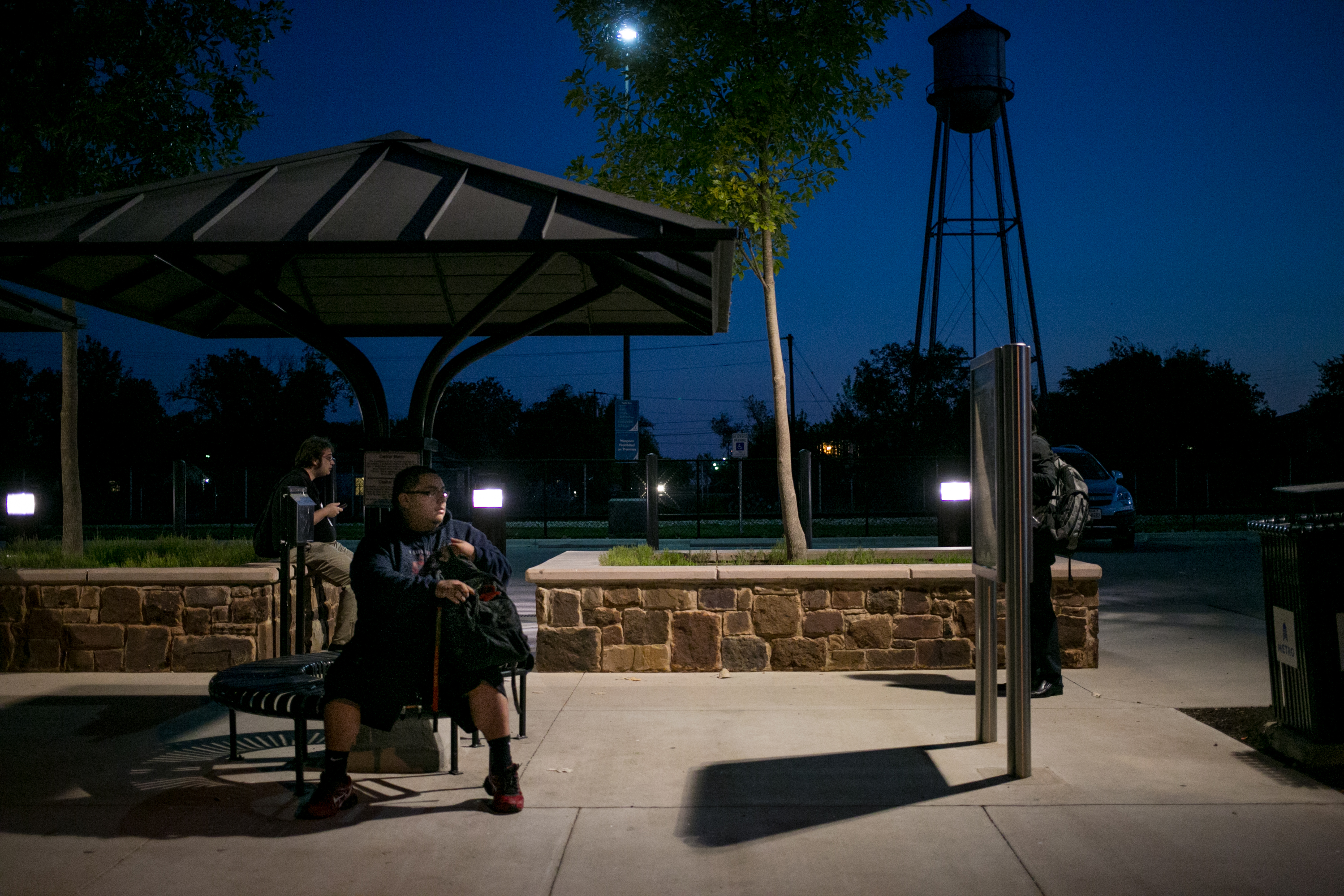
Ilana Panich-Linsman
Enlarge
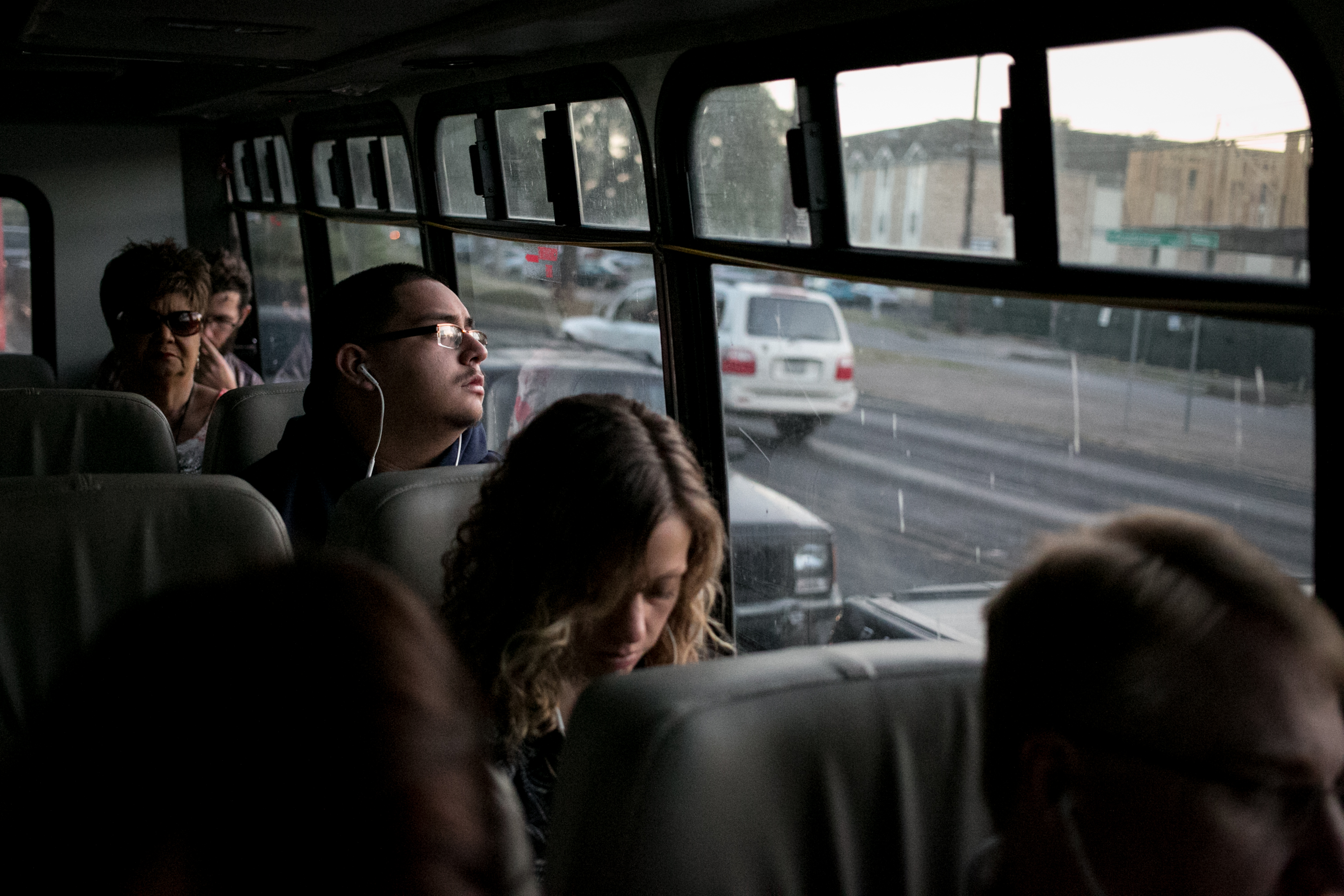
Ilana Panich-Linsman
Others appear to have come to similar conclusions. According to 2013 U.S. Census Bureau data, 12 percent of workers 16 years of age or older carpool to work — whether in Manor or someplace else — while only half of a percent use public transportation. The low public transportation use likely has to do with the fact that Manor does not yet have local bus service.
Some transit advocates are still holding out hope for the long-discussed Green Line passenger rail – also known as the “sausage link,” a play on Elgin’s famous cuisine – that would run between Austin and Elgin.
The Green Line is included in the 2040 Plan for the Capital Area Metropolitan Planning Organization, or CAMPO, as a $586.9 million project for possible funding starting in 2025.
As Capital Metro staff proposed in November 2014, the Green Line would be 28 miles long and stop at eight locations, including Elgin, Manor, Decker Lake and downtown Austin, with service every 20 minutes. It would utilize an existing line currently used for freight that Capital Metro already owns and, by 2030, could accommodate between 7,000 and 12,000 daily riders.
The Green Line’s inclusion in the 2040 plan – which envisions transportation growth in Travis, Williamson, Hays, Bastrop, Burnet and Caldwell counties – does not mean it will become a reality, however.
“It is a placeholder in case that funding is available,” said Javier Arguello, Capital Metro’s director of long range planning. He continued, “In order to make that funding available, we have to do a lot of homework. Capital Metro is working on developing the information that is required to justify the expenditure.”
Whether Capital Metro will be able to justify the spending – based, in part, on population and growth projections – is up in the air at this point. An answer could become more clear, though, as the agency develops its 10-year service plan, designed to help it develop and expand its fixed-route transit services and increase ridership, efficiency and connectivity through 2025.
Transportation Management & Design Inc., the consultant that Capital Metro hired to take on the task in September, intends to craft the plan with public input over the next year. It should be complete in fall 2016 and ready for implementation in early 2017.
“We are right now starting a modeling effort with a consultant, developing ridership based on CAMPO’s 2040 model,” said Arguello. “That will begin to give us the information that we are looking at to see if the expenditure can be justified with demographics and the development that will occur in the future in those communities.”
III. Patrolling Manor’s Streets
by Allison Sandza and Blair Waltman-Alexin, KLRU
As Manor grows, so does the city’s police force. In the past year Manor PD has added 8 new officers. Most of the calls come from one place: Walmart. But, as the once-small town deals with city problems like traffic and crime, Manorites say it’s not the “rough little town” it once was.
IV. 290 East: Toll or No Toll?
by Tyler Whitson, Austin Monitor
Manorites driving or carpooling to Austin have a few ways to make the trip, but each option seems to have its drawbacks.
Regardless of the route, the cost of gas can have a significant impact on one’s cost of living, partially offsetting the savings that might come with a move from Austin to Manor. Bessie Caceres, who lives in Manor, has seen her sister and brother-in-law experience this struggle.
“They were actually living in Austin before, but the rent is just crazy high, and so they decided to move to Manor,” Caceres said on Sept. 22. “Gas is cheaper now, but back then, they were like, ‘We’re just wasting all this money.’ Whatever they were saving on the rent, it was going towards the gas and everything else.”
With gasoline prices lower now, the impact is not as great, but there’s no telling what lies ahead for the capricious oil market. And in spite of the costs involved, 2013 U.S. Census Bureau data shows that about 80 percent of workers 16 years of age or older drive to work alone. This includes those working in the city and those commuting to other places.
Time, of course, is another major consideration.
For the shortest drive, commuters headed to Central Austin are likely to take U.S. 290 East – which slices through Manor – and I-35. The decision they face at that point is whether to take the 290 East Toll, which runs along 6.2 miles of 290 East, or the free frontage roads that run adjacent to it and stop at seven traffic lights.
While the toll road – also known as the Manor Expressway – offers a quicker commute, taking it for its full length costs $1.08 per direction for drivers with TxTag accounts and $1.44 per direction, plus a $1 processing fee per bill, for those who pay by mail. Drivers connecting to or from U.S. 183 to get to north or northwest Austin pay an additional 54 or 72 cents per direction, depending on whether they pay with TxTag or by mail.
Enlarge
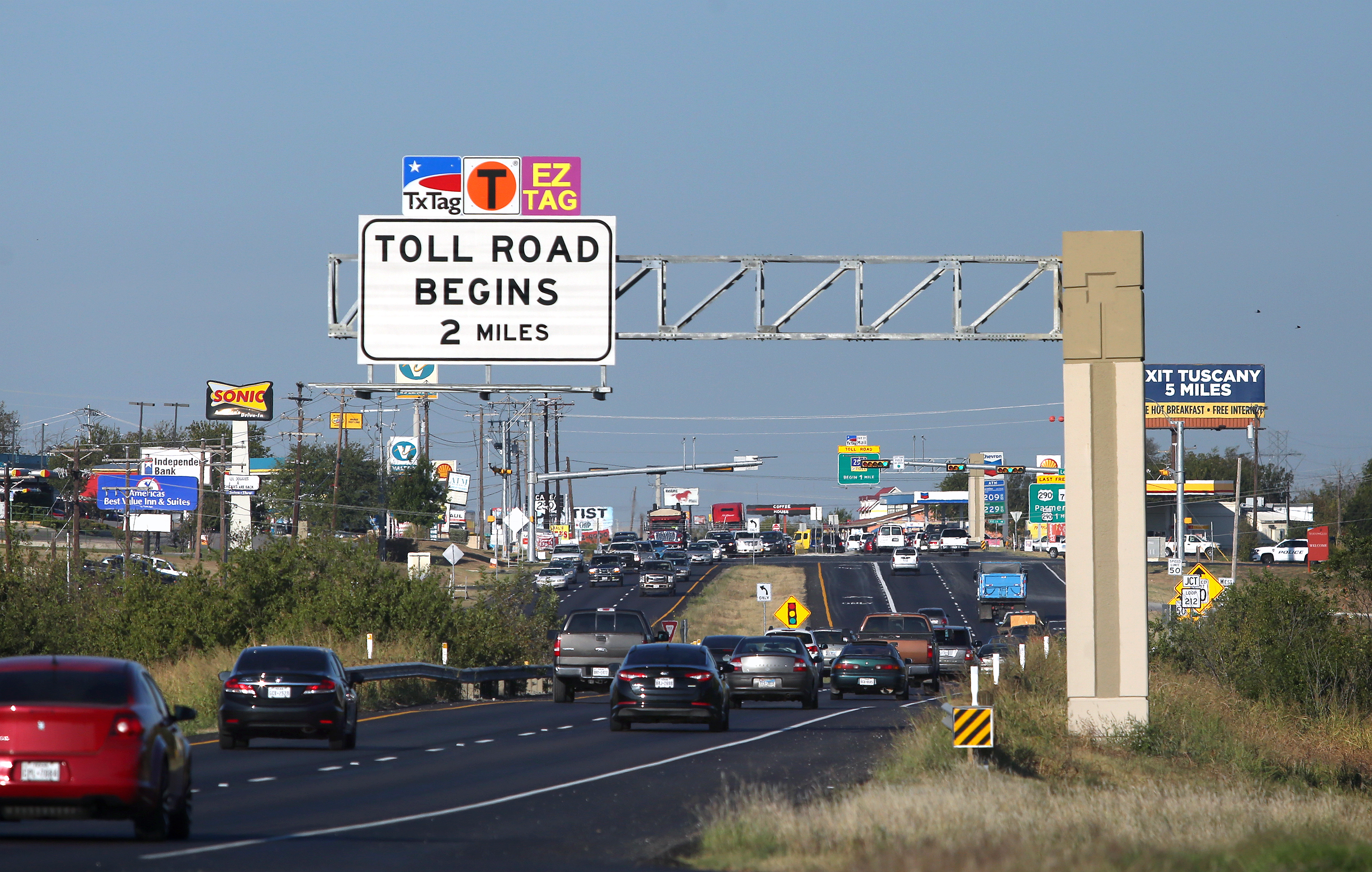
Jorge Sanhueza-Lyon
If one were to drive to and from work five days a week using the 290 East Toll, paying with TxTag and not connecting to U.S. 183, the cost in tolls would be a little over $43 per month.
Based on data provided by the Central Texas Regional Mobility Authority, the regional tolling authority that developed and maintains the 290 East Toll, usage has far exceeded expectations. Since the tollway opened in May 2014, average weekday transactions have steadily risen from 33,400 to a projected 65,200 for the month of September – nearly a twofold increase.
These figures are not limited to drivers commuting between Manor and Austin, nor do they count the number of actual cars getting on or off the highway. They do count transactions, though, which occur when a car passes through a toll gantry and gets charged a toll.
While the transactions show that 290 East Toll usage has gone up, a survey that the CTRMA commissioned and released on Sept. 30 found that more than half of toll road users surveyed take the express route for recreation and leisure, while a little over a fifth use it for work, less than a tenth use it to go to the airport and 2 percent use it for school.
In addition, 85 percent of respondents said they are satisfied with the toll road, and 9 percent said they’re not satisfied, stating that they don’t like paying tolls or are confused by the signage.
Only 30 percent of respondents live in the eastern part of the survey area, which includes Manor and the 290 East Toll itself, while 39 percent live west of I-35 and 31 percent live in the northern part of the survey area, which covers Pflugerville and its surroundings.
There are others, of course, who don’t use the toll road at all. Caceres and her family, for example, often use 290 East to get to Central Austin to pick up groceries and fulfill other needs. “We always drive back and forth. We bank in Austin and everything,” she said. “I personally do not get on the toll roads, because I don’t like paying to drive on the road.”
Even though she doesn’t use the toll road, Caceres acknowledged that she has seen traffic improvements on 290 East. “It’s not as bad. Now that the toll roads are there, I think it’s a little better now,” she said.
According to CTRMA spokesman Rick L’Amie, there was a 36 percent reduction in traffic on the 290 East frontage roads after the toll facility opened.
Caceres commutes more than 11 miles every weekday to get to work at 8 a.m. near the intersection of Parmer Lane and MoPac Expressway. She takes Parmer Lane because it makes the most sense for her commute, but she says that it’s a frustrating drive. “It’s usually very congested, so it takes me maybe a good 45 minutes or so to get to work,” she said.
Having lived in Manor for five years, Caceres said she has watched congestion increase as the population grows. “It’s just making everything so much worse,” she said.
